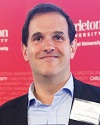Cellular Models to study the spread of COVID-19

Professor, Department of Systems and Computer Engineering, Carleton University
Novmeber 8, 2021 12:30 - 13:30
This is an online event. The details on how to join the event will be available once you register.
Register at EventBrite
abstract
Simulation models based on the traditional Susceptible-Infectious-Recovered (SIR) equations have been used to predict the pandemic dynamics. These models are being used at present to predict the spread of the disease in most countries worldwide. Studies of COVID-19 are based on theoretical methods for infectious disease dynamics, which show how the disease spreads. The original model has been used since 1927, and it classifies the individuals involved in the transmission of the disease into those that are Susceptible to the virus, those who are Infectious and finally those who have Recovered. The SIR model was extended and adapted numerous times to study the progression of other diseases and advanced new techniques. For instance, modern models include equations to represent Exposed individuals (SEIR model). More recent advances defined for modeling the SARS epidemics included behavior for the latency of the disease, and the effect of quarantines. Similarly, studies have investigated the effects of vaccination and isolation. These advanced models use network dynamics, ordinary differential equations, finite equation theory, and other theoretical studies on infectious diseases. Although these theoretical methods are useful to define the theory of disease, sometimes they are difficult to apply in practice.
As we have seen in the past few months, these methods, based on differential equations, are useful to predict the number of infected individuals, and to devise different global policies to control the pandemic. Nevertheless, these methods cannot be easily adapted to include newly available information on the disease, or to combine them with real world data on demand. Consequently, large teams of experts need to work together on models of the disease and their simulations, provide results with limited precision. Another major limitation of the theoretical models under use is the inability for mixing the results of the mathematical models with visualization tools and advanced graphical interfaces (including Geographical Information Systems – GIS -, Building Information Models – BIM -, and spatial diagrams). Such visualization tools are normally in high demand for better analysis and decision-making.
We will introduce the main characteristics of the Cell-DEVS formalism and will show how to model complex cell spaces using Cell-DEVS with application to COVID-19. We will present different examples of application for simulation of the spread of disease and discuss open research issues in this area. We will then focus on simple models of SIR applied to COVID-19 and will show how to include the models of spread of disease at a geographical level, as well as discussing the definition of models for indoor spread using integration of BIM software and GIS.
biography
GABRIEL A. WAINER received the M.Sc. (1993) at the University of Buenos Aires, Argentina, and the Ph.D. (1998, with highest honors) at UBA/Université d'Aix-Marseille III, France. In July 2000 he joined the Department of Systems and Computer Engineering at Carleton University (Ottawa, ON, Canada), where he is now Full Professor. He is the author of three books and over 400 research articles; he edited four other books, and helped organizing numerous conferences, including being one of the founders of the Symposium on Theory of Modeling and Simulation, SIMUTools and SimAUD. Prof. Wainer is the Editor-in-Chief of SIMULATION, member of the Editorial Board of IEEE Computing in Science and Engineering, Wireless Networks (Elsevier), and Journal of Defense Modeling and Simulation (SCS). He is the head of the Advanced Real-Time Simulation lab, located at Carleton University's Centre for advanced Simulation and Visualization (V-Sim). He is a Fellow of SCS
Last updated November 7, 2021

